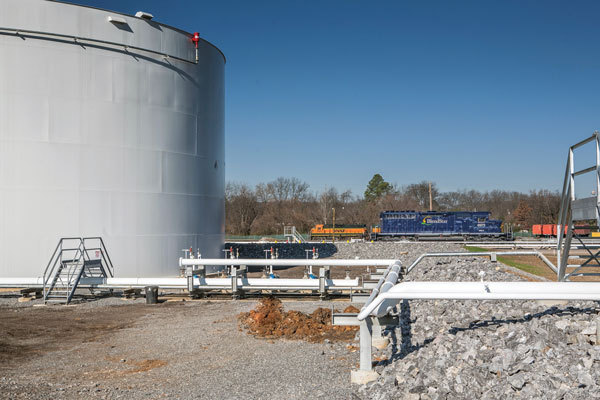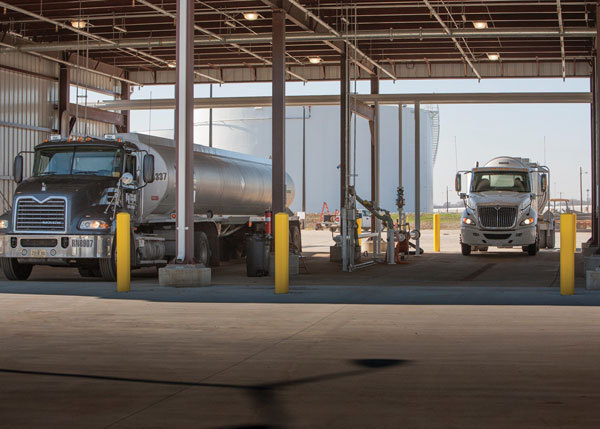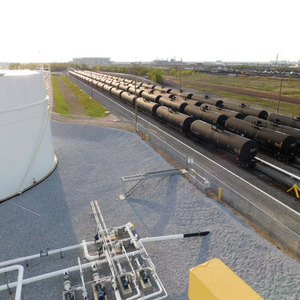Quick & Nimble




PHOTO: ECO-ENERGY
October 17, 2017
BY Susanne Retka Schill
The ethanol industry is working hard to build ethanol demand, focusing on retail infrastructure for E15 and flex fuels, which raises the question, is the rest of the system ready? A report last year from the National Renewable Energy Laboratory questioned whether current terminal capacity can handle higher blends such as E30, but ethanol marketers note that a move toward E15 is more of an incremental increase.
Between 70 and 80 percent of the midstream infrastructure supplying ethanol to blending terminals could handle E15 almost immediately, says Josh Bailey, CEO of Eco-Energy. The biggest constraints would be short-term tank reconfigurations at many of the smaller blending terminals. “It’s like a big puzzle,” Bailey explains. “You’re replacing 5 percent of gasoline with 5 percent of ethanol, but the overall finished fuel demand is not changing.” But issues could arise in some areas, he says. “We believe there are certain areas that could transition to E15 tomorrow and be able to handle it efficiently and there are others that need some time, attention and investment.”
Steve Bleyl, executive vice president of ethanol marketing at Green Plains Inc., agrees and notes that E10 is now available across the country. “We have large-scale, high-volume terminals in place today, most of which are able to handle incremental volume. While some terminals will need additional investment with incremental volume, that build-out can move quickly—the bones are built.” He adds that the rail-to-truck transloading business model is very nimble, and will quickly fill in any holes.
Building Capacity
Midstream ethanol infrastructure has evolved along different trajectories in different regions, Bailey says. Much of the investment in the past decade focused on the Gulf and East coasts, primarily because the majority of the terminals could not receive ethanol by rail. Served by pipeline for conventional fuels, rail access was ripped out to make room for commercial buildings and housing as populations grew in places such as Dallas, Houston, New York Harbor and Atlanta. Rail-to-truck facilities popped up on the outskirts to transload product into the terminals. On the West Coast—Tacoma, Seattle, San Diego and Phoenix—big investments weren’t necessary because terminals still could receive ethanol by rail. “They didn’t have to invest a lot to be in business,” Bailey says. “I think in order to handle an incremental 50 percent demand growth, some of those areas will require more investment.”
It is difficult to know just how many rail-to-truck transloading facilities there are across the country, Bleyl says. “It can be hard to identify as they are often used exclusively for a specific supplier or end user. They are also nimble sites and come online and offline as needed to service demand.” He predicts these facilities will continue to be a great business model in some markets—generally lower-volume or specific customer-served locations.
“In larger markets, that model has shifted to state-of-the-art terminals,” he says. Bleyl highlights three benefits to the 24-hour unit-train offloading facilities: “The high-speed and volume offloading reduces turn times on equipment; rail service providers can organize and coordinate power more efficiently; and ample inventories ease supply concerns with customers.”
The savings for shippers can be substantial. While transloading a train with 80 cars is going to cost 3 cents per gallon, the same as going through a state-of-the-art terminal, Bailey says, the advantage comes from reduced turn times for rail cars. “To transload a train with 80 cars is going to take three to five days to pump the ethanol into trucks,” he explains. Combining the transit time for a unit train with 24-hour unloading can shorten the turnaround time from a range of 25 to 45 days to 13 to 15 days. The savings from fewer rail cars needed is substantial. “Where terminals create value and generate return for investors like Eco is we attract more volume and shippers because they ultimately are saving money on other costs in the supply chain,” he says.
Being able to unload a unit train with 2.3 million to 2.8 million gallons of ethanol in 24 hours requires adequate storage, which is attractive to the demand side of the equation, Bailey says. “People value the fact there’s inventory on hand at these terminals, rather than being fully reliant on the railroad and rail cars.” He recalls the recent winter when a polar vortex brought cold temperatures that, combined with large grain crops and increased volumes of oil shipments by rail, wreaked havoc on rail shipments. “There were numerous locations across the U.S. that had strong logistical difficulties because they solely relied upon rail and didn’t have their own storage,” Bailey says.
Rail-Ready
The companies investing in midstream ethanol infrastructure for biofuels, such as Eco-Energy and Green Plains Partners, are relatively few. “The major buyers and blenders—the Exxons and Marathons of the world—really don’t have capital allocated to biofuels infrastructure,” Bailey says. Downstream pipeline companies and terminal operators typically don’t make investments without three- to five-year commitments, which is not common in biofuels, he adds. “What’s left is primarily marketers like Eco and some third-party terminal operators.”
Eco-Energy has eight unit-train terminals, coming in second for throughput capacity in the nation, handling a little more than 1 billion gallons of ethanol annually, according to Bailey. Kinder Morgan Inc. ranks first with six terminals receiving unit trains, per its ethanol business unit webpage. One of those is a transloading facility in Lomita, California, while the others have 24-hour unit-train offloading capabilities. KMI handles ethanol in terminals in Baltimore; Dallas/Ft. Worth; Linden, New Jersey; Richmond, California; and its Deer Park Terminal in Pasadena, Texas. KMI also has partnerships with other firms, such as Archer Daniels Midland Co. and Bailey Feed Mill in Selma, North Carolina, which held a ribbon-cutting ceremony in late September. The new facility at the feed mill will offload a 96-car unit train in 24 hours, delivering the ethanol to KMI’s nearby Selma terminal via a 2.6-mile pipeline.
Green Plains’ subsidiary Blendstar, has seven fuel terminals taking in rail, one of which can handle 96-car car unit trains in Birmingham, Alabama. In late 2015, Green Plains announced a joint venture with Delek Holdings Inc. to build a unit-train terminal in Maumelle, Arkansas. Another project for Arkansas was announced in 2016—an expansion of JP Energy’s terminal at North Little Rock to accommodate unit train deliveries, along with an interconnection agreement for a pipeline with an affiliate of Magellan Midstream Partners.
There also have been notable investments in export infrastructure, with considerable expansion in the Texas Gulf. Green Plains invested in a joint venture at the Jefferson rail terminal and Valero has a new terminal in Galveston, plus Kinder Morgan’s Deer Park Terminal is situated on the Houston shipping channel for export capability as well.
From production to marketing infrastructure, the ethanol industry has made significant investments, Bleyl says. “Over the past three to five years, we have seen the industry make big steps to invest in itself by pushing efficiency in all levels of the supply chain, from production to distribution.” Combining export and domestic facilities, there are between 25 and 30 sites capable of handling unit volumes, he estimates. “The industry has noted that we need additional capacity to increase our exports, and we need more efficient terminals owned by the industry.”
Author: Susanne Retka Schill
Freelance Journalist
retkaschill@yahoo.com
Advertisement
Advertisement
Advertisement
Advertisement
Related Stories
CARB on June 27 announced amendments to the state’s LCFS regulations will take effect beginning on July 1. The amended regulations were approved by the agency in November 2024, but implementation was delayed due to regulatory clarity issues.
SAF Magazine and the Commercial Aviation Alternative Fuels Initiative announced the preliminary agenda for the North American SAF Conference and Expo, being held Sept. 22-24 at the Minneapolis Convention Center in Minneapolis, Minnesota.
Saipem has been awarded an EPC contract by Enilive for the expansion of the company’s biorefinery in Porto Marghera, near Venice. The project will boost total nameplate capacity and enable the production of SAF.
Global digital shipbuilder Incat Crowther announced on June 11 the company has been commissioned by Los Angeles operator Catalina Express to design a new low-emission, renewable diesel-powered passenger ferry.
International Air Transport Association has announced the release of the Sustainable Aviation Fuel (SAF) Matchmaker platform, to facilitate SAF procurement between airlines and SAF producers by matching requests for SAF supply with offers.
Upcoming Events










